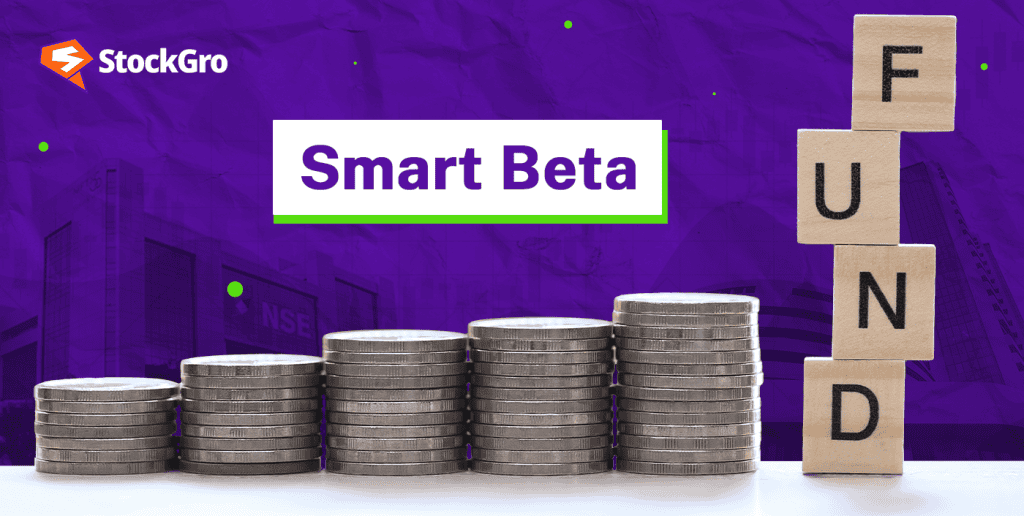
From conventional methods, investing has advanced significantly. Many investors used to rely on straightforward tactics like purchasing stocks or investing in market-tracking index funds. Even though these techniques are still widely used, investors’ options are always changing along with the financial environment. Presenting smart beta Funds, a cutting-edge strategy that surpasses traditional index investing.
Smart beta funds present a special fusion of passive and active investing approaches. Investors can benefit from both active stock selection and passive index tracking in a single investment vehicle thanks to this combination.
This article will describe what smart beta funds are, how they operate, their advantages, and the possible risks to consider before investing.
What are smart beta funds?
An innovative form of investment, smart beta funds combine the best features of active and passive management techniques. These funds’ primary goal is to increase returns or lower risks by tracking an index strategically.
Smart beta funds use extra guidelines or considerations to enhance performance over time, unlike traditional index funds, which merely replicate a market index based on market capitalisation.
In other words, by concentrating on particular elements like value, volatility, momentum, or dividends, smart beta funds provide a more focused approach to investing. This gives investors access to the potential for higher returns through active stock selection and the wide diversification of a passive fund. The outcome is a “smart” strategy that blends a more deliberate approach to stock selection with the effectiveness of index tracking.
How do they differ from traditional index funds?
By maintaining the same shares in the same ratios as the market index, traditional index funds seek to mirror its performance—that of the Nifty 50 or Nifty 100. Bigger companies have more influence on the performance of the index considering their market capital weighting.
Unlike traditional index funds, smart beta indices pick and weigh equities according to alternative criteria such as value, momentum, size, quality, or low volatility. In an attempt to raise returns and reduce risk, this approach emphasises specific features over simply market capitalisation.
For instance, by selecting the 30 least volatile equities from the Nifty 100, the Nifty 100 Low Volatility 30 index gives less volatile firms more weight. During market corrections, this tactic reduces downside risk and evens out portfolio movements.
Active and passive investing are combined to create smart beta indices. They provide a compromise between actively managed funds and traditional index funds by passively investing in index constituents while adhering to a set of preset rules based on selected criteria.
Factors affecting smart beta funds
Investors can access a wide range of factors beyond traditional market capitalisation through smart beta funds. Understanding these elements will help one to unlock the possible benefits of smart beta funds.
- Value: Value investing aims to find underpriced stocks concerning their inherent worth. Targeting equities with low price-to-book (P/B) or price-to-earnings (P/E) ratios, value-oriented smart beta funds typically target additional value-related criteria. These markers help find stocks with great potential for expansion.
- Quality: Quality-oriented smart beta funds give companies with excellent financials, stable profitability, and low debt top importance. These funds place a high weight on profitability, effective management, and good government if we are to create portfolios resistant to market volatility.
- Momentum: Smart beta funds driven by momentum benefit from the inclination of winning stocks to keep growing. These funds invest in firms that have lately demonstrated strong price performance, betting that the market will continue to rise.
- Low volatility: Low volatility methods centre on stocks with generally consistent price swings. By lowering their exposure to high-risk equities and thereby shielding portfolios from significant market fluctuations, these smart beta funds give investors a more seamless investment experience.
- Size: The inclination of size-based smart beta exchange-traded funds to favour smaller firm stocks in their portfolios is known as their small-cap factor. The basis for this approach is the belief that smaller businesses have more room and growth possibilities, which might finally lead to better returns.
Smart beta benefits
Smart beta funds offer the following benefits when weighed against actively managed funds and traditional exchange-traded funds (ETFs):
- Portfolio diversification: Smart beta funds let investors diversify their holdings by applying equal or fundamental weighting approaches. This adaptability helps investors to better match their assets to their investment goals, therefore enhancing the performance of their portfolio.
- Lower risk: Usually mirroring the performance of an index, Smart Beta Funds are lower-risk investments. For investors seeking to limit risk and maximise returns, they are therefore a preferred alternative.
- Cost efficiency: These funds cost less than actively controlled ones. Still, they often produce higher returns than traditional ETFs, offering a reasonably cheap way to raise portfolio performance.
- Enhanced returns: By adding premium, fast-growing stocks to the index, smart beta funds can provide better returns. The possibility of better performance than traditional index-tracking funds is increased by this active adjustment.
Risks and considerations
While smart beta funds have notable benefits, there are also some drawbacks to consider:
- Lower trading volume: Compared to more established funds, smart beta or factor-based funds in India have lower trading volumes because they are still relatively new. The declining volume could make it more difficult for investors to sell their shares at market value, affecting liquidity.
- Liquidity issues: Besides lower trading volumes, smart beta funds could run against liquidity problems. Purchasing or selling their shares at the intended price could prove difficult for investors, influencing their capacity to make quick investment decisions.
- Higher costs: Though usually less expensive than actively managed funds, smart beta funds often have higher expense ratios than conventional ETFs. Regular portfolio rebalancing can also lead to higher transaction costs and churn, which over time could lower returns.
Also read: The impact of stock volume on market movements
How to invest in smart beta funds
Investing in smart beta funds is one great way to diversify your portfolio and follow development. Here are some reminders to keep in mind should you be considering applying this approach to meet your financial goals:
- Diversify strategies: You can distribute your risk by combining several Smart Beta strategies—focusing on cheap stocks (value), financially strong companies (quality), or consistent ones with low volatility.
- Set a benchmark: Select an index or benchmark to assess your Smart Beta fund’s performance. It will allow you to examine the fund’s performance in relation to the overall market.
- Watch expense ratios: Choose funds with lower ratios of expenses. Remember that increased fees may reduce the returns you hope to obtain from smart beta investing.
- Reinvest dividends: Invest whatever dividends you get to maximise compound returns. Usually, the most successful long-term strategy for Smart Beta investment is this one.
- Balance with active funds: Spend a significant amount of your passive investments in smart beta funds, but don’t use them for your whole portfolio. For additional diversification, think about combining them with funds that are actively managed.
- Monitor holdings: Make sure your smart beta fund’s holdings align with the particular strategy you’re pursuing by reviewing them regularly.
- Tax considerations: Consider the tax implications of smart beta ETF investing. To make informed choices, compare their after-tax returns with other options.
You can successfully integrate smart beta funds into your larger investment strategy by following these steps.
You may also like: Expense ratio in mutual funds: How does it impact your returns?
Is smart beta right for you?
By focusing on particular investment criteria that have historically outperformed the market, smart beta funds provide the possibility of larger returns. By diversifying across these variables, they also seek to lower risk, which, in contrast to traditional active funds, may offer a more stable investing experience.
However, there are drawbacks to smart beta funds as well. Compared to conventional index funds, they might be more complicated and charge higher fees. Furthermore, their performance is not assured and may differ based on the state of the market and the particular elements they aim to achieve.
Your best choice for smart beta funds will depend on your investing goals, risk tolerance, and understanding of the underlying methods. If you are looking for a compromise between active and passive investing and are at ease with a more sophisticated approach, smart beta funds could be a great addition to your portfolio.
You may also like: What is alpha and beta in the stock market?
Bottomline
Investors trying to improve their strategy and find more specialised investing opportunities may find a great use for smart beta funds. Before deciding whether Smart Beta Funds are right for you, you should consider your financial goals, risk tolerance, and investment expertise.
FAQs
- What is a smart beta fund?
One investing fund with a smart beta is one which, using a rules-based approach, chooses and weights stocks based on certain criteria including value, momentum, size, quality, or low volatility. Unlike market-cap-weighted conventional index funds, smart beta funds concentrate on these other traits to strive to improve returns and reduce risk, therefore offering a balance between passive and active investment strategies.
- Is smart beta investing really smarter?
For some investors, smart beta investing is wiser since it targets particular factors like value, momentum, or low volatility using a rules-based approach, therefore improving returns and lowering risk. However, its success relies on the selected elements and the state of the market. Understanding the approach and matching it with your investment objectives is crucial as it is not assured to outperform conventional index funds.
- What are smart beta strategies in India?
Popular smart beta approaches in India consist of low volatility, momentum, quality, and value. The NIFTY 100 Minimal Volatility 30, for instance, targets companies with minimal price volatility while the NIFTY 200 Momentum 30 targets firms with excellent recent performance. By choosing and weighting companies according on particular criteria instead of market capitalisation, these techniques seek to increase returns and lower risk.
- What are smart beta disadvantages?
Among numerous drawbacks of smart beta funds are greater costs resulting from rebalancing and more portfolio turnover. They can also go for long stretches of underperformance relative to conventional index funds. Furthermore, more complicated and somewhat difficult for investors to grasp are smart beta methods. Finally, under some market situations, they could have less liquidity and more volatility.
- Is beta a good investment?
For someone trying to strike a mix between active and passive approaches, smart beta can be a wise investment. By stressing particular elements like value, momentum, or low volatility, it seeks to improve returns and lower risk. Its performance changes with the state of the market, though, and it could have more complexity and expenses. To find out if your risk tolerance and investment goals complement your approach, evaluate them.

